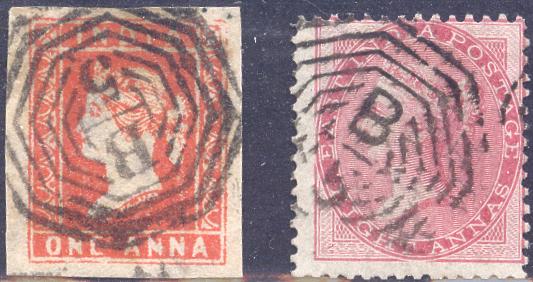
Myanmar - Birmanie
Note: on my website many of the
pictures can not be seen! They are of course present in the cd's;
contact me if you want to purchase them: evert@klaseboer.com.
Burma issued its own stamps from 1937 on. Before 1937 the stamps of India were used. Some examples of stamps of India with a "B5" numeral cancel of Akyab.
I have also seen a 2 a 1854 stamp of India with this "B5" numeral cancel of Akyab. Click here for more information on these cancels.
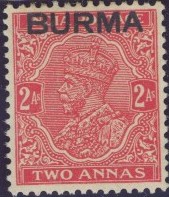

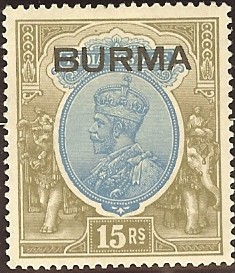
3 p grey 1/2 a green 9 p green 1 a brown 2 a red 2 a 6 p orange 3 a red (overprint at the bottom) 3 a 6 p blue 4 a green 6 a light brown 8 a lilac 12 a red 1 R green and brown 2 R yellow and red 5 R lilac and blue 10 R red and green 15 R green and blue 25 R blue and orange
With overprint "SERVICE": 3 p grey, 1/2 a green, 9 p green, 1 a brown, 2 a red, 2 a 6 p orange, 4 a green, 6 a light brown, 8 a lilac, 12 a red, 1 R green and brown ("SERVICE" larger), 2 R orange and red, 5 R lilac and blue, 10 R red and green.
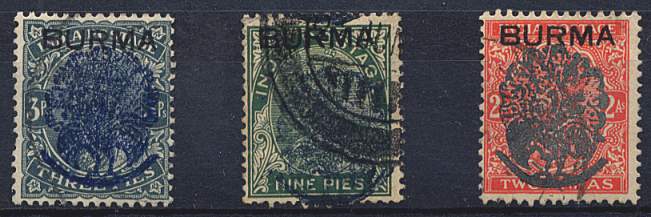
Overprinted with a Peacock during the Japanese occupation, images
obtained from a Sandafayre auction
I have also seen postal stationary with King George V (1 a brown, king in an ellipse) with "BURMA" overprint.
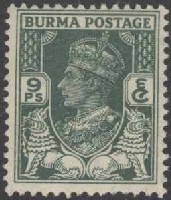
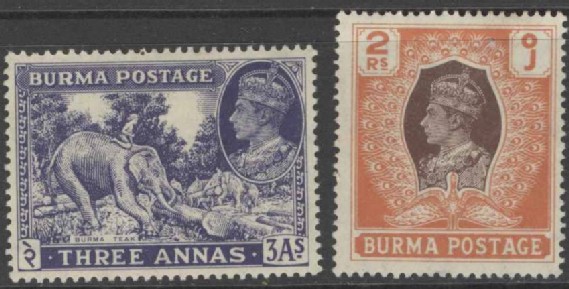
Small sized stamps (dragons or lions at the sides): 1 p red (1940), 3 p violet, 3 p brown (1946), 6 p blue, 6 p violet (1946), 9 p green (1946), 1 a brown, 1 a blue (1946), 1 1/2 a green, 1 1/2 a orange (1946), 2 a red, 2 a lilac (1946), 4 a blue, 4 a lilac (1946).
Larger sized stamps with various designs: 2 a 6 p red (Royal
barge), 2 a 6 p blue (Royal barge, 1946), 3 a violet (elephant
moving teak), 3 a blue (1946), 3 a 6 p blue and light blue (Burma
rice), 3 a 6 p blue and black (Burma rice, 1946), 8 a green (the
Irrawaddy), 8 a lilac (the Irrawaddy, 1946).
Large standing size: 1 R blue and lilac (peacock), 1 R lilac and
blue (peacock, 1946), 2 R violet and brown (design as 1 R), 2 R
orange and brown (design as 1 R, 1946), 5 R red and blue (statues
at sides), 5 R brown and green (statues at sides, 1946), 10 R
green and brown (design as 5 R), 10 R violet and lilac (design as
5 R, 1946).

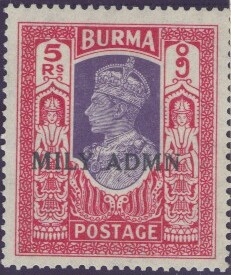
With overprint "MILY ADMN" (1945): 1 p red, 3 p violet, 6 p blue, 9 p green, 1 a brown, 1 1/2 a blue, 2 a red, 2 a 6 p red, 3 a lilac, 3 a 6 p blue (now in one colour only!), 4 a blue, 8 a green, 1 R blue and grey, 2 R lilac and brown, 5 R red and blue, 10 R green and brown.
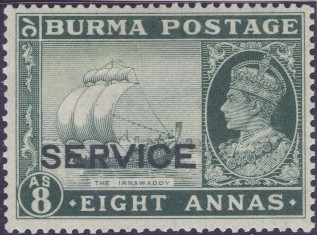
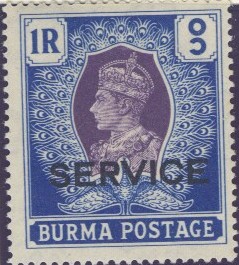
With overprint 'SERVICE' (1939): 3 p violet, 3 p brown (1946), 6 p blue, 6 p violet (1946), 9 p green (dark or light green), 1 a brown, 1 a blue (1946), 1 1/2 a green, 1 1/2 a orange (1946), 2 a red, 2 a lilac (1946), 2 a 6 p red, 2 a 6 p red (1946), 4 a grey, 4 a lilac (1946), 8 a green, 8 a lilac (1946), 1 R blue and violet, 1 R lilac and blue (1946), 2 R violet and brown, 2 R orange and brown (1946), 5 R red and blue, 5 R brown and green (1946), 10 R green and brown, 10 R violet and lilac (1946), the word 'SERVICE' is larger on the larger sized stamps.
With overprint "COMMEMORATION POSTAGE STAMP 6th MAY 1840" (1940): "ONE ANNA 1 A" and bars on 2 a 6 p brown.
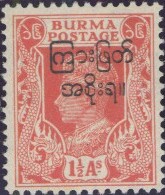
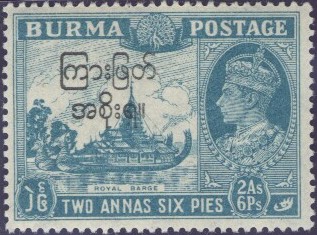
These stamps also exist with a Burmese overprint (1947): 3 p brown, 6 p violet, 9 p green, 1 a blue, 1 1/2 a orange, 2 a lilac, 2 a 6 p blue, 2 a 6 p blue, 3 a blue, 3 a 6 p blue and black, 4 a lilac, 8 a lilac, 1 R lilac and blue, 2 R orange and brown, 5 R brown and green, 10 R violet and lilac.
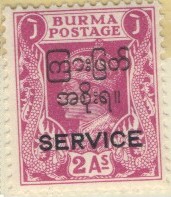
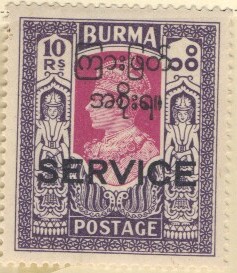
With Burmese overprint and "SERVICE" (1947): 3 p brown, 6 p violet, 9 p green, 1 a blue, 1 1/2 a orange, 2 a lilac, 2 a 6 p blue, 4 a lilac, 8 a lilac, 1 R lilac and blue, 2 R orange and brown, 5 R brown and green, 10 R violet and lilac.
1942 Peacock overprint on Burma stamps
A nice website on forged overprints can be found at: http://www.bilston73.freeserve.co.uk/idiot/idiot.htm. It states that all envelopes with "JAPANESE SPECIAL SERVICE POST" are forged. The stamps with "MILY ADM" were not overprinted (some forgers use these stamps and cover the text with their peacock forged overprint).
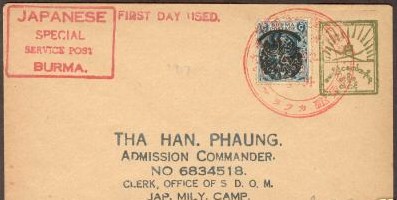
Forged envelope with "JAPANESE SPECIAL SERVICE POST
BURMA"
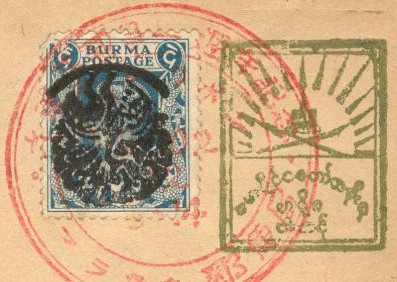
Zoom-in
I've seen many of these envelopes addressed to: "THA. HAN. PHAUNG. ADMISSION COMMANDER NO 5834518. CLERK, OFFICE OF S D.O.M. JAP. MILY. CAMP. MOULMEIN RANGOON. BURMA."
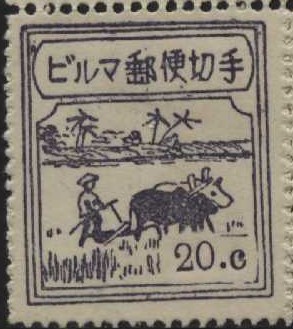

The 30 c is probably genuine. Genuine stamps have the value
impressed in the paper.
Farmer design: 1 c orange 2 c green 3 c blue 5 c red (small 'C' or large 'C') 10 c brown 15 c lilac 20 c violet 30 c green 1 F red
There exist many forgeries of stamps similar to above stamp (farmer issue); for a review of the forgeries see: http://www.bilston73.freeserve.co.uk/farmers/farmers.htm
A nice site on the forgeries of the 'Yano seal stamps' (second image above) can be found at: http://www.bilston73.freeserve.co.uk/Yano/Yano.htm. The Yano seal stamp was the first stamp to be issued under the Japanese occupation.
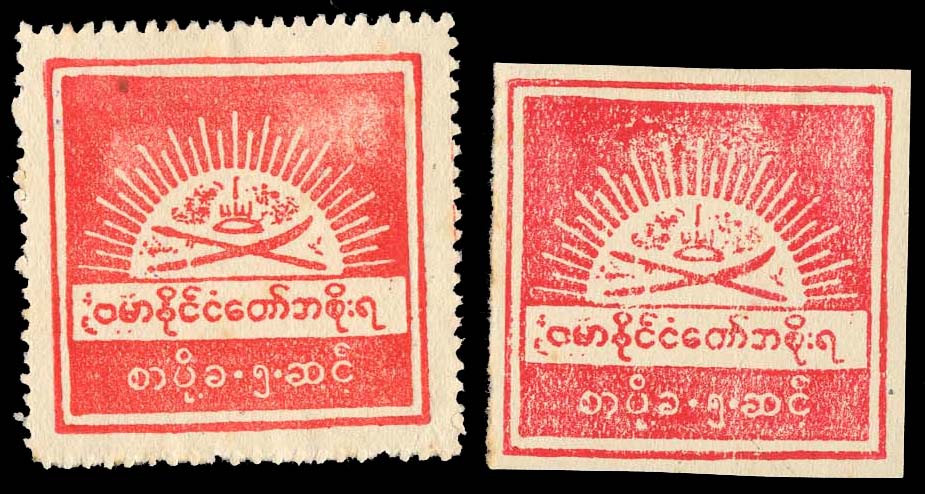
Two other forgeries of the Japanese occupation stamps.
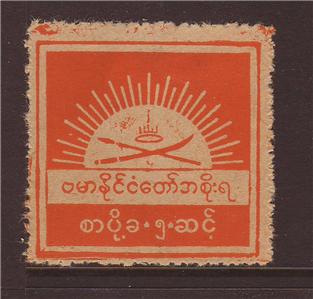
Possibly genuine stamp
Other stamps of the Japanese occupation:
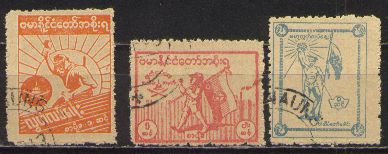
1943 Independence day, 1 c orange, 5 c red and 3 c blue; reduced
sizes
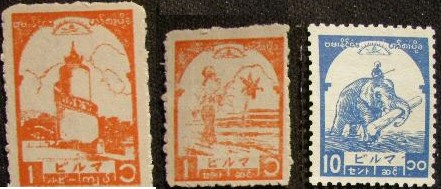
1943 issue Japanese occupation of Burma, tower, woman and
elephant carrying wood
In the above designs exist:
Elephant carrying wood: 5 c red, 10 c blue, 15 c orange, 20 c
green, 30 c olive
Woman: 1 c orange, 2 c green, 3 c violet,
Tower: 1 R orange, 2 R violet.
Forgeries exist of at least the woman design (see Focus on Forgeries by Varro Tyler).
Cart with oxes (similar in design to the 1943 elephant issue) 1 c brown 2 c green 3 c violet 5 c blue Local woman 10 c blue 20 c red 30 c olive
All the above stamps exist with an overprint of two lines in Burmese script.
9 p blue (map with Birmese man) 1 1/2 a violet (map with Birmese woman) 2 a red (map and statue) 3 a 6 p blue (map with elephant)
1/2 a green 1 a lilac 2 a red 3 1/2 a blue 8 a brown
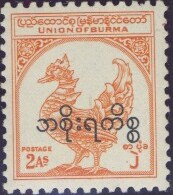

Burma 1949 stamp with official overprint and 1968 stamp
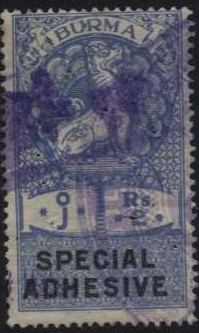
Burma fiscal stamp "SPECIAL ADHESIVE"